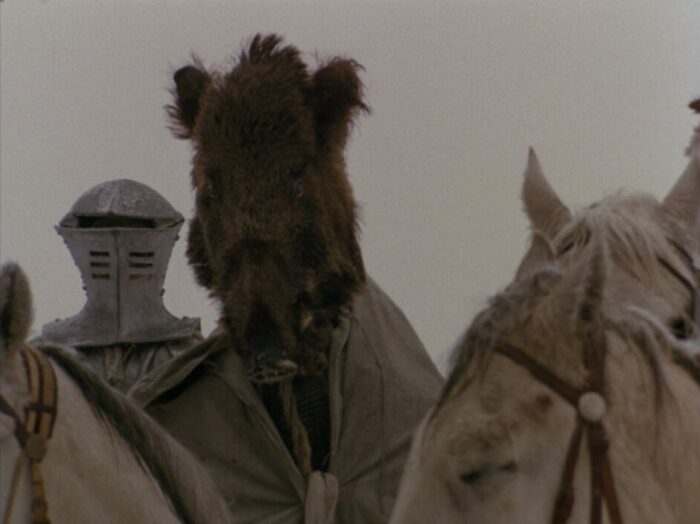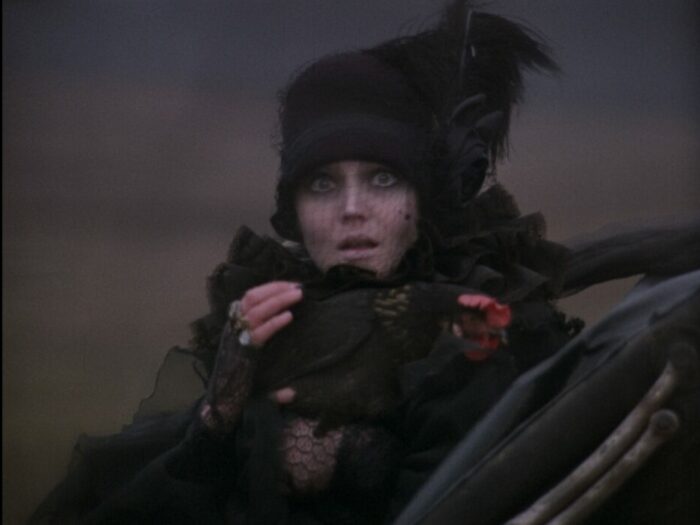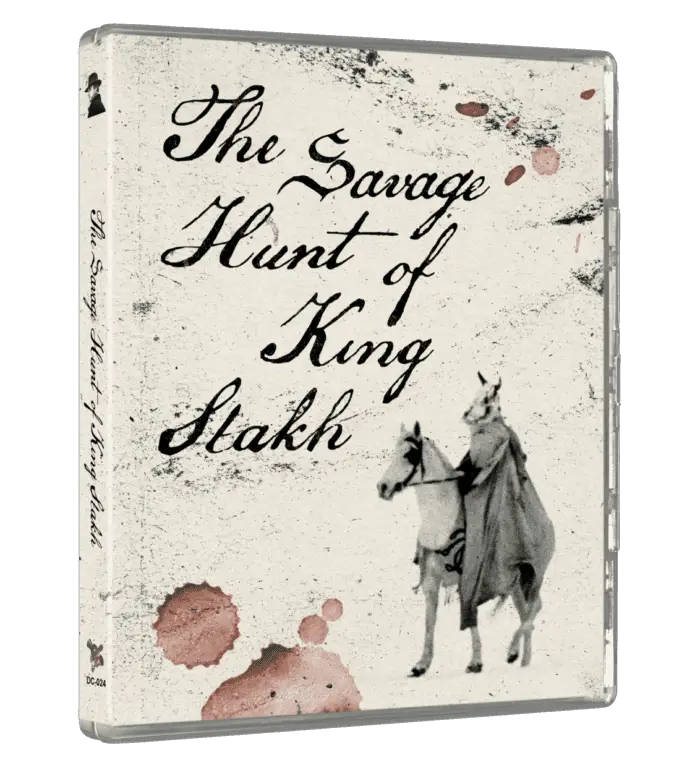Cult movie fans have cause to rejoice this week with the remastering and re-release of the Belarusian folk-horror film The Savage Hunt of King Stakh, restored to its full length for a special edition courtesy of Deaf Crocodile and DiabolikDVD. Replete with a host of special features, the new restoration brings the film’s haunted mansion—full of curses, suffering, ghouls, monsters, duels, and, of course, one indeed savage hunt—and its denizens back to life.

The film is adapted from the 1964 novel King Stakh’s Wild Hunt by Uladzimir Karatkievich, a work loosely rooted in European folklore. The “Wild Hunt,” so goes these tales, whether from Scandinavia, Germany, or Russia, whether in ancient, medieval, or even early modern lore, is that of a spectral pack of hunters in full flight, straddling black horses and bucks, blaring out horns as they pillage and kill through the night; townspeople who witness them might fall to their violence or join them in thrall. The novel and film both append to this legend a modernist conceit: that of the scholar studying the lore of the region, but coming into all-too-close contact with his subject.
The Savage Hunt of King Stakh begins with concerns the researcher’s visit to the mansion of the Marsh Firs in the year 1900—a time when science and modernity were progressing rapidly and civilizations questioned long-held traditions. There he, Andrey Beloretskiy (Boris Plotkinov, The Ascent) meets first the mansion’s pale, sickly, yet beautiful mistress Nadezhda (Elena Dimitrova), whose accursed family still bears, after four centuries, the sting of their bloody encounter with the vengeful King Stakh.
Countess Nadezha lives with only a nurse who tends to her illness with incantations and herbs and a manager of the property who lurks behind its innumerable columns, parceling out the mansion’s secrets. Nadezha is the last remaining ancestor of the Janowsky family: four centuries ago their forefather Roman betrayed his friend, the violent, vengeful King Stakh; in return, the King’s spirit each year commemorated his death with the “wild hunt,” a midnight ride of revenge against his betraying friend’s survivors. Andrey is of course intrigued by both the legend, the subject of his scholarly inquiry; he’s also smitten by the beautiful countess. When he accepts her invitation of lodging while he researches his subject, he learns more about the family’s curse—and falls further and further into the centuries-old intrigue that prompted it.

The Savage Hunt of King Stakh presents an intriguing conceit and a strong cast, especially with Plotkinov and Dimitrova as the leads. The set design, with its elaborate Eastern European architecture, is suited perfectly to its gothic themes. Even the dedicated efforts of Deaf Crocodile’s Craig Rogers’ restoration can’t quite lend the image any sheen: most of the film is presented in a washed-out palette nearly devoid of color, and, as a consequence, the depth of detail that might render its muted sets more lustrous. (The primary set, Pidgoretsky Castle in Lviv Oblast, features also in the prior year’s D’Artagnan and the Three Musketeers, where it practically glistens in its richly saturated hues.) The muted grading of Savage Hunt may have been the filmmakers’ intent, but it does not result in much in the way of an invigorating cinematic expression until the film’s final act, mostly shot outdoors in the wild of winter, where the harsh elements enhance the terrifying ride of the spectral hunters.
It is really only in that final act, as the “Savage Hunt” of the past, the centuries-long curse of King Stakh against the Janowskys, begins to unfold, with Andrey finding himself in the midst of the action, that the film comes to life. Until then, it can be as maddening as the estate manager, constantly lurking in the shadows and meting out little bits of information: for the most part, the film’s first two acts consist primarily of characters doing little than exchanging exposition about events that happened long, long ago. Upon its initial release, the New York Times reviewer of the era, Janet Maslin, was harsh in her critique: “The tale is presented in a drab and confusing fashion by film makers with only the faintest command of their craft.”
As savage as Maslin’s critique was, there are times when it seems on the mark: the film’s direction is marred not only by its incessant exposition, but by some twitchy camera operation (including at least one cinematographer a little too in love with the zoom) and odd editing. And yet, the film retains a degree of charm with its surreal imagery as Andrey encounters bleeding skulls, skulking dwarfs, screeching ravens, and beheaded puppets in his quest to learn the truth of the Janowsky family curse. With its strong leads, gothic vibe, menagerie of weirdness, and a clever ending that brings together science and legend, The Savage Hunt of King Stakh is well worth a watch in its restored version. It may not be a classic of world cinema, but it is exactly the kind of lesser-known work that Deaf Crocodile specializes in restoring and giving new life.

The Blu-ray version of the film featuring the restoration of the Director’s Cut is packaged with a host of special features, all of them newly commissioned for this volume, including two commentary tracks, two booklet essays, and two video features.
- Audio commentary track by comics artist, film historian, and author Stephen R. Bissette
- Audio commentary track by Mike White
- ”The Wild, Wild Hunt of King Stakh,” a new video essay by film historian Evan Chester
- Video introduction by filmmaker and author Kier-La Janisse
- Packaged in a slipcase with a 60-page illustrated booklet including:
- New essay by film historian & professor Peter Rollberg
- New essay by film critic Walter Chaw
- New art by Beth Morris and comics artist David W. Mack
With the release of The Savage Hunt of King Stakh, Deaf Crocodile Films will be working exclusively with DiabolikDVD, the largest independent online distributor of specialized home video releases, as its distributor for Deluxe Slipcase Edition Blu-rays and other special home video releases. Deaf Crocodile will also offer for the first time a subscription service beginning in July that guarantees subscribers Deluxe Edition Blu-ray releases shipped early before regular commercial release.
The Savage Hunt of King Stakh is available for purchase through DiabolikDVD and Deaf Crocodile’s own website.



